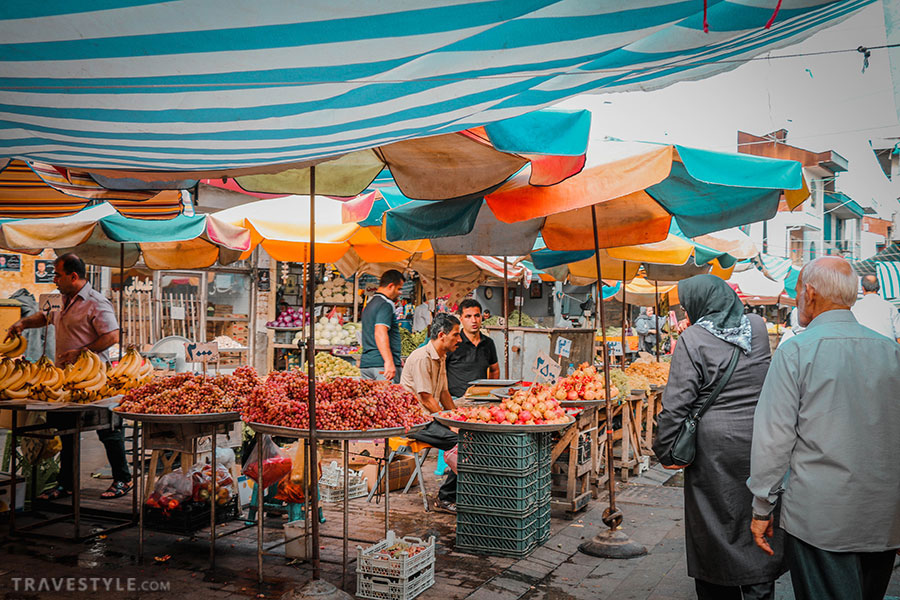Bazaars in Iran have existed since the Sasanian empire (224–651 AD) in their current form. But places designed for trade have existed long before within Persia. Like many other Islamic countries in the region, Iranian Bazaars are crucial parts of every city usually located close to the Jameh Mosque. Bazaars in Iran are so much than a place of trade. They are a social institution where important events take place, where history is made and where people of all social classes mingle together.
From a tourist’s perspective, they are a great place to understand the local culture, witness social interactions and of course buy Iranian souvenirs.
With the reach of Islam, Bazaars received an extra value. Additional features such as a school, Tekieh for Islamic ceremonies, hammam and caravanserai were added to answer the needs of bazaaris and visitors. The bazaar became an important place for both the merchants and royals – as the royal’s survival would be dependent on the economic stability of their territory and also keeping the traders happy. Throughout history, bazaaris have played a significant political role in Iran’s constitutional revolution, the nationalization of Iranian oil and also the Islamic revolution.
The souq (bazaar), according to Eugene Wirth, is the only innovation that one can find in the Muslim city in comparison with other types of cities. Other scholars, like Geertz, see the souq as a cultural form, a social institution, and an economic type and suggest that if Islamic civilization can be characterized by one of its leading institutions, then the souq should be the prime candidate.
Bazaars in Iran are many. Every single city comes with a local bazaar and plenty of daily markets. They are vibrant, busy and a must-visit for every visitor. It’s safe to say that a trip to Iran wouldn’t be complete without a visit to a few bazaars at least.
I’ve traveled far and wide in Iran. I’ve lost count of all the bazaars I’ve visited but here’s a list of my top bazaars in Iran. Some are regularly visited by tourists and others are lesser-known. But most of them can be visited on my suggested 2-week itinerary for Iran.
12 Bazaars in Iran you must visit:
#1 Minab Thursday Market, Hormozgan province
Minab is a small town less 1:30 hours drive from Bandar Abbas. It has a traditional bricked bazaar and a Thursday market that makes my top bazaar experience in Iran. I don’t think I’ve ever been as fascinated by any bazaar in Iran. Which is why I’ve written a whole post about Minab’s Thursday market on the blog. I’ve hardly ever heard of tourists visiting it. But if you do get the chance, then you’re in for one hell of an experience.
It’s literally the most colorful bazaar in Iran dominated by some badass women. Even as an Iranian, I was surprised to see how local women had such a significant role in the trade of the region even if they looked very conservative at first sight. What was even more amazing is that they were all doing business dressed in their traditional clothing.
To visit the market, you’d definitely need half a day. Minab is easily accessible from Bandar Abbas and I’d highly recommend the visit if you’re looking for a unique experience.

#2 Tabriz bazaar
Tabriz is the best example of Islamic bazaars in Iran. It’s the biggest roofed bazaar in the world perfectly-known for its Timcheh Mozafarieh where the most intricate carpets are sold. The bazaar of Tabriz is the biggest bazaar in Iran and it’s recognized as a UNESCO world heritage. You could easily spend a whole day wandering through its alleyways. It’s also relatively easy to get lost in. And apart from great shopping, there’s plenty of local restaurants and mosques to be found within the bazaar.

#3 Tajrish Bazaar, Tehran
Tajrish Bazaar has become rather popular with tourists in the past few years. But still, many prefer a visit to the Grand Bazaar instead. While Tajrish is definitely not as big as the Grand Bazaar of Tehran, it offers a very unique experience. The most significant part of Tajrish bazaar is dedicated to food. And unlike most bazaars in Iran, it doesn’t just offer spices and nuts but a whole variety of fresh ingredients.
The variety of fruits and vegetables here is even a surprise for the locals. From the craziest tropical fruits to specific wild herbs, you’ll find it all here. It’s open every day of the week but gets super crowded before Nowruz, the Persian New Year.
The bazaar also holds religious plays and special ceremonies during the month of Muharram.
#4 Qeysarieh bazaar of Esfahan
When there’s any talk of Esfahan bazaar, many think of the bazaar surrounding Naqsh-e Jahan square. But the main bazaar of Esfahan is actually called Qeysarieh with its main entrance opening in Imam square. If you want to ditch the touristy souvenir shops and get better prices, taking a stroll within Esfahan’s Qeysarieh bazaar is a must.
My top recommendation is to free yourself of guidebooks and maps and let yourself get lost in the bazaar. Make sure you peak into open doorways to find the best architectural secrets.

#5 Jome Bazaar (Friday Market) of Tehran
If you’re after a treasure hunt, have a soft spot for antiques and care to support local creatives, Jome bazaar of Tehran is the perfect place to be on a Friday morning. The market opens from 8 in the morning until 3 pm. It’s basically a huge 5 story parking packed with local sellers. Everyone can get a stall at Jome bazaar at a fairly cheap price. It’s a great place for young designers to showcase their work. It’s also a great place to find Iranian antiques at a cheaper price. Bargaining is at full pace here and prices are cheaper than other places.
If you’re lucky to be in Tehran on a Friday, head over here early in the morning as it can get super crowded.
#6 Darvazeh Kazeroon Market in Shiraz
Darvazeh Kazeroon is rarely known to foreign tourists. It’s the first market in Shiraz dedicated to fresh food and it’s where many of the locals buy their fruits and vegetables. ّDarvazeh Kazeroon bazaar is an old-world charm. You can easily witness that the shop keepers have owned their shops for decades, they recognize their regular customers and there’s this familiar social interaction you would expect from an old bazaar.
There’s also a beautiful but tiny mosque situated at the end of the market where you’ll see many of seller heading to at prayers time. Anything from fresh veggies and fruits, to nuts, tea, and bread is to be found in the bazaar. There’s also an amazing fish market located right next to it.

#7 Yazd Gold Bazaar
Yazd gold bazaar is a small section of the famous Khan bazaar in the city and probably a favorite spot among local women. The gold in Yazd is valuable and handmade. You’d notice that it also tends to be extra yellowish which might not be everyone’s cup of tea. But if you’re into buying a piece of handmade jewelry, Kheirollahi gold shop is the oldest shop in the bazaar with great reputation.
Make sure you read our guide to the top things to do in Yazd, before arriving in the city.
#8 Bandar Abbas Fishmarket
If you happen to be in Bandar Abbas on your way to visiting Qeshm or Hormuz island, then a stop at the local fish market is a must. There are all kinds of fish and sea creatures to be found here. There are also a few women outside the bazaar who would be willing to cook the fish for you at a fair price.
#9 Rasht bazaar
Rasht is with a doubt my favorite Persian food destination in Iran. It’s no wonder that its bazaar is probably among the most delicious food bazaars in Iran. There’s everything from seafood, to tea and fresh veggies but my absolute favourite part is the long array of pickles and olives.
#10 Ganj Ali Khan bazaar, Kerman
Ganjali Khan Bazaar in Kerman is part of the great Ganjali Khan complex that includes an impressive mosque, one of the best-preserved hammams, a school, caravanserai, and the bazaar. The copper section of the bazaar is my favourite but there’s plenty of other stuff to look for as well. While wandering around the bazaar keep an eye on the intricate plasterwork and watch out for creepy mannequins. 😉
#11 Tehran carpet bazaar
The Grand Bazaar of Tehran has lost much of its authenticity throughout the years and it’s mostly dominated by Chinese products. The carpets section of the bazaar, however, is another story. There’s a huge 3 story section dedicated to all kinds of carpets. From delicate silk carpets from Tabriz and Qom to wool carpets made by Iranian nomads. Beware that some sellers might actually follow you around and insist on visiting their shop. You’d want to go here with a strong ability to decline unwanted offers or you’ll be back a few carpets under your arms.
#12 Vakil bazaar of Shiraz
In my opinion, the Vakil Bazaar in Shiraz is among the most beautiful bazaars in Iran. Anything from silver, to antiques, carpets, and handicrafts can be found here. The bazaar is not too big and you easily visit it in a few hours without getting lost. I personally love the spice section and the carpets. Make sure you stop for a saffron ice cream in one of the few cute cafes in the bazaar.
So that’s a wrap! I do hope you manage to visit a few of these bazaars in Iran on your trip to Iran. Just keep in mind that most of the bazaars mentioned apart from Tajrish, Jome bazaar, the Minab bazaar are closed on Fridays and even closed on Thursday afternoons.











Lovely ! I really liked the bazaar in Kashan too. It felt very authentic and the architecture in some areas is splendid !
Thank you so much Emma! 🙂
The bazaar in Kashan is pretty amazing as well.
Beautiful photos and great advice! I agree that Tabriz is one of the best!
Thank you Carlie. Tabriz bazaar is absolutely amazing. 🙂
Really Really nice photos. You are great photographers. Can I ask what gear do you use?
Thanks! I use a Canon 70D. 🙂
For me Isfahan Bazaar is by far is the most authentic Bazaar in Iran
Which city is the best for buying Persian carpet?
Probably Tehran because it’s the capital & you have many many options to choose or Tabriz
Iran is beauty, Love from Pakistan..♥️
Pingback: بازار بزرگ بندرعباس یکی از دیدنی ترین جاذبه های گردشگری استان هرمزگان -
Pingback: بازار بزرگ بندرعباس یکی از دیدنی ترین جاذبه های تاریخی استان هرمزگان -